Many dog web sites and trainers urgently point out that some dog owners are not always aware of the stress signals their dogs show. Some go into various degrees of detail in listing them, explaining the different levels, and a few in tailoring them to your dog. Next, they discuss how to avoid these stressors. But, then it all ends.
Instead, I’ll go a bit past that, into the Rest of the Story.
Signals and Signs – The List of Lists
While these were gathered from many different sources, my first change was to separate them into two different groups. The first group are the signals often used to communicate things, while the next group are more of the dog’s own responses to stress. There is a very large difference when you look at how these are used, so how are they missing this difference?
Stress signals
- Panting
- Licking
- Yawning
- Drooling
- Freezing in place
- A worried look, or furrowed eyebrows
- Large pupils
- Frantic behavior/movement
- Pacing
- Agnostic aggression
Stress responses
- Excessive shedding
- Hiding
- Moist or sweaty paw pads
- Red or goopy eyes
- Displacement behavior
- Loss of appetite
- Whining or barking
- Excessive Sleeping
- Fear Aggression
- Shaking (as when wet)
- Peeing/Pooping in unusual places
- Sudden appearance of white dandruff on the back/shoulders
- Unusual repetitive behavior
- Very reactive
- Shut down, ignoring things
Some old standards
Piloerection (hackles raised)
Many years ago I recall some actual research examining a link from piloerection to stress and fear aggression. They did find one, but only in one specific breed, and only then in the rear hackles. For all the others, it simply meant a high degree of arousal, which could be most anything, and varied wildly with the individual dog. More often than not, this was from excitement at approaching something they really like or want to do.
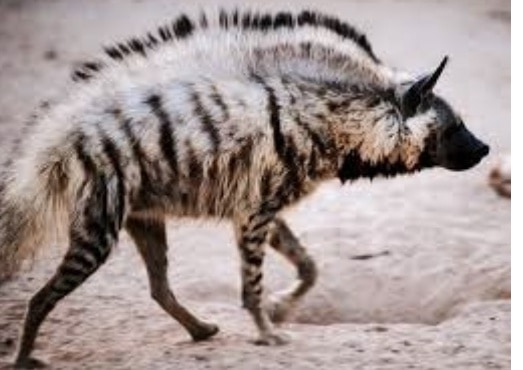
Tales of the Tail
Similar to hackles, it was once thought that a tail raised and stiff or bristled indicates stress and possible aggression. Again, and similarly, this widely varies with individual dogs. One of my dogs does this when first meeting a smaller dog that he likes.
Flattened Ears
I still see dog trainers who are afraid to approach a dog with flattened ears, insisting this is fear aggression. Sure, it could be, but this is often something very different.
Some Sources
Some of the places I looked at, to get a good sample of their opinions of stress signals and advice.
- VCA Pet Hospitals
- DogToplia
- American Kennel Club
- PetMD
- Hills Pet Food
- Positively – Victoria Stilwell
- The Dog People – Rover.com
- PetSafe
What to Do Next
“If your dog is stressed, first remove him from the stressor.”
“If your dog becomes consistently stressed, see your veterinarian.”
VCA Pet Hospital
Exercise, Physical contact, Massage, Music therapy, Time-out, Calming shirt
CC SPCA
Desensitzation, counter conditioning, manage exposure, pheromones, flower essences, music
Victoria Stilwell
These seem to be typical of the advice commonly given. But what I find quite curious is that stress is a very common component of life. The first time you’re about to learn to swim in a pool or meet a bunch of new people at a school or job you are likely to feel some stress. Should I then turn away from the pool, turn my back on the new people, and just walk away? Or perhaps just wear a calming shirt, play some music, and get a massage?
And even the counter-conditioning approach is just somebody else deciding on some alternative behavior you should take, which they may believe will reduce the stress, with the main focus on making your behavior more acceptable to them. However, you still might not be able to swim!
Why Not Confront the Issue?
But what if I teach you how to swim? If I introduce you to the bunch of people and teach you how to go around and meet them? In general, what if I teach the dog how to handle the situation in a manner that satisfies him? And one of the direct implications of that is the dog having some amount of choice in how the situation is handled, in their picking a satisfying solution.
If somebody walks up to me, one of my dogs is always up front and ready to greet them. But two others will stay back at first. They may decide to come forward, but know that they can hang back or even move behind me and not be bothered. And if somebody should walk directly up to them, they know how to calmly handle the situation. (One should always remember that people are an acquired taste.)
Personally, I think that’s a really great approach to use, that one terrific word that I almost never see in any of those so-very professional articles: teach. If you were scared of the water but learn to swim and enjoy it, then you can swim without stress.
Why Do You Need This
Most dog owners aren’t always aware of the stress signals that their dogs show in times of anxiety, fear, aggression, and even over-excitement. Knowing your dog’s stress signs can help you help him or her in any given environment, and in life overall. Dogs tend to have a “package” of their own stress signs that they will exhibit, versus a different set of signs that another dog will show.
Another helpful thing to know about stress signs in dogs is that they tend to be very “linear,” as in, he or she will often show consistent signs, in progressive order, one after another after another if he or she is in a stressful state or stressful situation.
For example, when stressed, your dog may first start panting, then yawns, then dandruff appears, then has enlarged pupils, etc. – the stress signs will usually progress in the same order whenever he or she is stressed.
Arie’s DogLand Facebook, 1/7/2021
Not only very true, but Arie brings up a few typical characteristics that almost nobody else seems to mention. Just like with wagging tails, people tend to look for simple and singular factors to go by. I have heard so very many people just insist that each specific sign means exactly what their book says, and nothing else. Even if the book notes that this may vary between dogs, that’s often only a note near the end, and never remembered.
For a specific dog, how consistent are these signs? For the short term, they’re usually very stable. But for very young dogs or those just learning social skills, they may vary a bit as the dog learns new things that work better for them.
But, what almost none of them seem to cover comes in the next section.
What Do They Really Mean
The list of signals above is more than just stress signs. And for many dogs, many of those signals are more commonly used for purposes beyond simple stress indicators.
Signals and Corrections
In signaling other dogs, these can influence the other dog’s behavior. This may range from simply saying no to an invitation to play or other activity. Or just that the other dog’s behavior is annoying you. A young pup could be running directly at my dog’s face. His eyes open wide, his head turns slightly away, and he freezes. The other dog stops dead, and waits for an approach signal, or walks away if none is given. Sure, you could say that my dog was stressed, but what does that really mean? It’s surely not something he doesn’t like, as he’s trained hundreds of other dogs. Perhaps more just a state of mild arousal?
Now, say the other dog didn’t listen, after my dog went through a whole sequence of escalating stress signals. Well, that often gets a bit noisy for a few days, until the other guy starts picking up on the basics. In that case you could say that my guy has gotten a bit stressed, but there is rarely any reason for me to intervene. That’s because here we are dealing with teaching. My dog has learned how to teach other dogs, and the result of all this teaching will be a reduction of stress in both dogs.

Anybody who has ever really watched social adult dogs teaching young pups will have seen many of those signals given. These are sometimes called corrections and are a form of agonistic behavior that is intended to effectively communicate and avoid aggression. You’ll find more detail on that at the links.
If two dogs are involved, always first check the other dog’s behavior. People who immediately intercede upon seeing any of those signals may cause developmental issues and future aggression if their dog is prevented from learning social skills.
A very common scenario is a dog saying that she’s scared and please don’t approach, which may include some teeth, a low growl, or even an air snap. If the other dog stops, then calmly walks away, all is fine. However, very frequently the owner yells at their dog for being nasty, trying to stop that behavior. If they have success with this, then the other dog will get no warning and may come right up to their dog’s face before they lose it all. And that owner has just caused a dog fight and aggression that may worsen over time.
Role-Playing and Games
Next, we have the games and the role-playing. When you see a few good friends in a wild chase with each other, somehow they have to say if they’re getting too close or too rough. And some of them will run wild, then flip over on the ground and have the others just pile on. When it gets too much, they simply freeze in place, the other dogs leave and stand back, waiting for the next round.
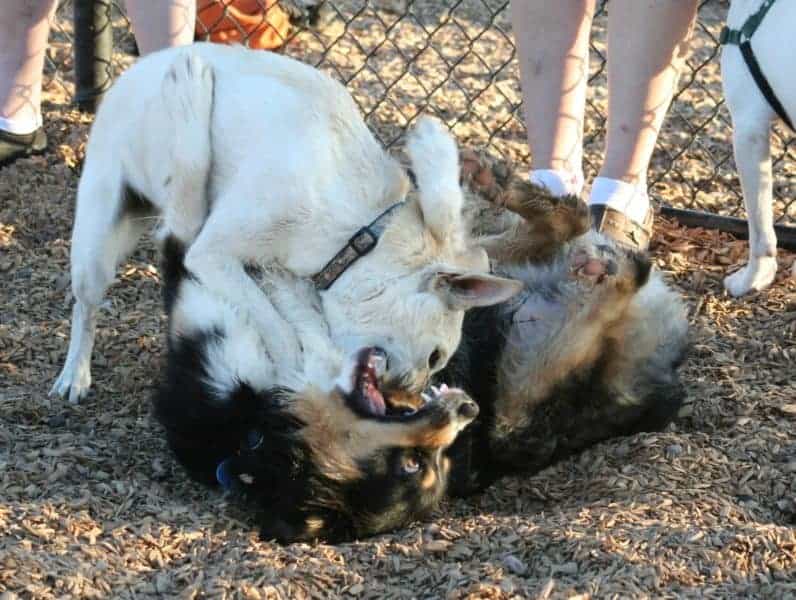
Or take the fence-running games, where many dogs work hard to look as vicious as possible. There, the highly fence-reactive dog may appear very similar to the playing dogs, but he’s not controlled or in sync with other dogs. A subtle difference you won’t find in most books. Now, both of those cases may be about the same high level of stress. This difference is the playing dog is still in control and is experiencing fun instead of fear.
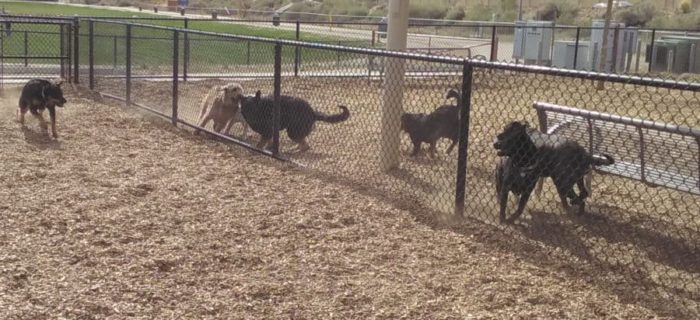
At one time we had a bunch of regulars sitting on the benches, while just behind them a half-dozen dogs were fence-running against a gal in the other side. All was loud but peaceful. Then a newbie dog joined the group, and several people jumped up upon hearing an expletive uttered (by a dog). The new guy had not yet learned the rules, and he (stressfully) redirected on a dog next to him. With a bit of watching and coaching, he caught on pretty quickly.
Stressful Stress
Finally, we have the unpleasant type of stress, which we’d like to get rid of. It could be the dog not knowing how to handle the situation, so we teach him. Or, there could be some underlying anxiety that prevents him from readily learning, so we first go after the anxiety. And this is where my earlier separation of stress signs comes into play, because here we’d see and work with the stress responses.
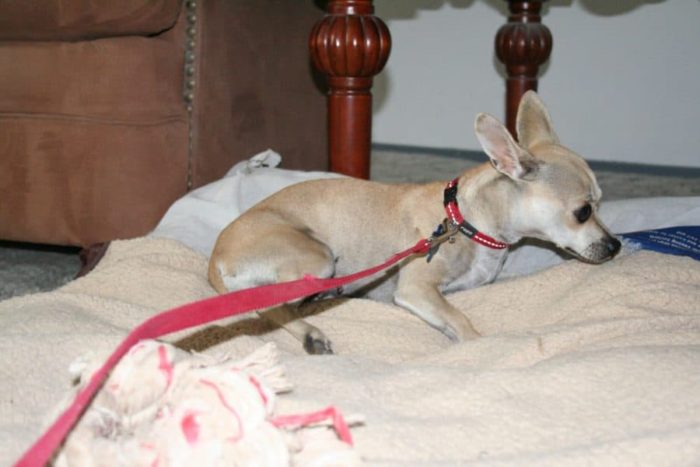
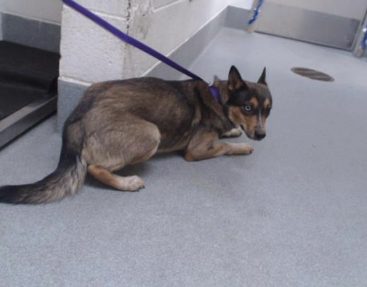
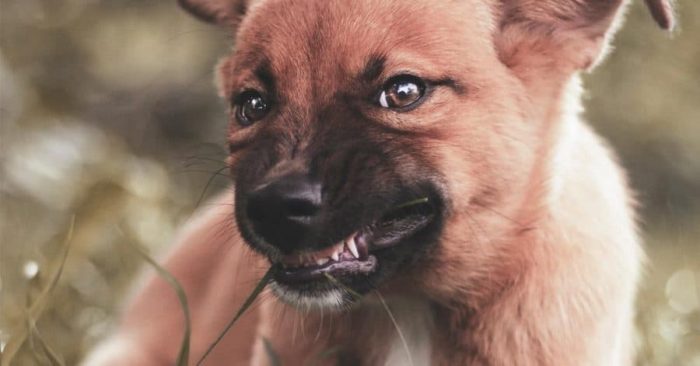
And it’s rare to see only a single point of stress anxiety, but more often a collection. As both the stress and learning are cumulative, always start with the least intense and simplest case, then work forwards. You’ll find much more of this in The Anxious Dog.
Single Point of Stress
After months of training, my new dog, Bandi, seemed ready to take on the world, Until, that is, we ran into a kid on a skateboard. He first started moving forward out of curiosity, then realized that he had no idea what this was all about, and ran behind me.
As he was fine with most anything else, we just took some walks, increasingly closer to a local skateboard park. These days, he often visits a small, local skateboard park, and made a bunch of friends with the kids there.
Stress, In Conclusion
Stress signals can vary from a call for help to just communication used during play or to avoid aggression. It’s the stress responses that need more attention, and the biggest emphasis here should be on teaching the dog an acceptable method of dealing with this, that they also find satisfying.
That is a far more effective approach than just removing the dog, or perhaps counter-conditioning using jargon like: a desensitizing extinction of positive reinforcement, while wearing a calming shirt, with nice music in the background.
